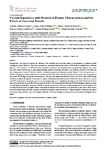Mostrar o rexistro simple do ítem
Current experience with obstetrical events: characteristics and the effects of nocturnal periods
| dc.contributor.author | Blanco López, Susana | |
| dc.contributor.author | Peteiro Mahía, Laura | |
| dc.contributor.author | Navas Arrebola, Rocío | |
| dc.contributor.author | López Castiñeira, Noelia | |
| dc.contributor.author | Pértega-Díaz, Sonia | |
| dc.contributor.author | Seoane-Pillado, Teresa | |
| dc.date.accessioned | 2024-05-21T07:21:39Z | |
| dc.date.available | 2024-05-21T07:21:39Z | |
| dc.date.issued | 2024-03-25 | |
| dc.identifier.citation | Blanco-López S, Peteiro-Mahía L, Navas-Arrebola R, López-Castiñeira N, Pértega-Díaz S, Seoane-Pillado T. Current experience with obstetrical events: characteristics and the effects of nocturnal periods. Clin Exp Obtet Gynecol. 2024;51(4):80. | es_ES |
| dc.identifier.issn | 0390-6663 | |
| dc.identifier.uri | http://hdl.handle.net/2183/36554 | |
| dc.description.abstract | [Abstract] Background: The object is to analyze the influence of the nocturnal period and lunar phases on the frequency of obstetrical events in pregnant women. Methods: This was a retrospective, transversal observational study of 1409 births in a hospital from northwest Spain (α = 0.05; precision = ±2.65%). A review of patients’ clinical records was performed recording the following data: labor onset type, date of last menstrual period, parity, gestational age, duration of pre-labor and labor, type of delivery, the hour, work shift, and lunar phase pattern of events. Statistical evaluation included descriptive and inferential analysis. Results: Labor was spontaneous in 58.3% of all cases; spontaneous deliveries accounted for 54.2% of the total and 19.2% were instrumental. In the cases of spontaneous labor onset, 48.5% began during the nocturnal period. The early labor phase was less than 6 hours in 62.7% of cases (44.8% during the full moon phase). During the nocturnal period, rupture of membranes and dilation periods of less than 3 hours were more common, with 32% of spontaneous membrane rupture occurring during a full moon. A significant dependence was observed between the labor type and nocturnal period, as 40.8% of all spontaneous births, 36.2% of instrumental births and 46.9% of emergency cesarean sections occurred during the night shift. Furthermore, 66.3% of precipitous deliveries (<3 hours) took place during this period. Conclusions: The nocturnal period is related to a higher number of spontaneous rupture of the membranes, non-intervention in the onset of labor, shorter early labor phases, faster deliveries, spontaneous births and emergency caesarean sections. A higher frequency of spontaneous rupture of the membranes, a full labor, early labor phases of less than 3 hours and emergency caesarean sections was observed during full moon phases. | es_ES |
| dc.language.iso | eng | es_ES |
| dc.publisher | IMR Press | es_ES |
| dc.relation.uri | https://doi.org/10.31083/j.ceog5104080 | es_ES |
| dc.rights | Creative Commons Attribution 4.0 International Licence (CC-BY 4.0) | es_ES |
| dc.rights.uri | http://creativecommons.org/licenses/by/3.0/es/ | * |
| dc.subject | Pregnancy outcomes | es_ES |
| dc.subject | Obstetrical deliveries | es_ES |
| dc.subject | Circadian rhythm | es_ES |
| dc.title | Current experience with obstetrical events: characteristics and the effects of nocturnal periods | es_ES |
| dc.type | info:eu-repo/semantics/article | es_ES |
| dc.rights.access | info:eu-repo/semantics/openAccess | es_ES |
| UDC.journalTitle | Clinical and Experimental Obstetrics & Ginecology | es_ES |
| UDC.volume | 51 | es_ES |
| UDC.issue | 4 | es_ES |
| UDC.startPage | 80 | es_ES |
| dc.identifier.doi | 10.31083/j.ceog5104080 |
Ficheiros no ítem
Este ítem aparece na(s) seguinte(s) colección(s)
-
GI-GIRS - Artigos [94]






